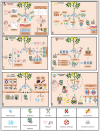Bacillus Species: Excellent Biocontrol Agents against Tomato Diseases
- PMID: 38543508
- PMCID: PMC10972177
- DOI: 10.3390/microorganisms12030457
Bacillus Species: Excellent Biocontrol Agents against Tomato Diseases
Abstract
Tomatoes encounter many pathogens, such as fungi and bacteria, which reduce the yield and quality of plants and lead to large losses in production. The application of plant protection products (PPPs) is still an important and most effective measure to control plant diseases. However, the use of chemicals in agriculture contributes to environmental pollution and biodiversity loss, and it can also threaten non-target living organisms. Biological control is a widely accessible, environmentally safe, and cost-efficient alternative for the prevention and suppression of plant diseases. Bacillus species with antimicrobial and plant growth-promoting effects are most frequently used as biocontrol agents to increase the resilience of agricultural production against biotic stresses. The present review discusses the antagonistic mechanisms and the biocontrol potential of Bacillus spp. against tomato diseases caused by different pathogens. The main mechanisms of Bacillus spp. include the production of antimicrobial compounds (antibiotics, extracellular enzymes, siderophores, and volatile compounds), competition for nutrients and space, and induced systemic resistance (ISR). Although Bacillus-based PPPs have been developed and commercialised worldwide for various crops and pathogens, the efficiency issues are still subject to debate. Additionally, a combined strategy for controlling tomato diseases based on Bacillus spp. and other available methods (conventional or natural-based) is a promising research field.
Keywords: Bacillus; biocontrol mechanisms; disease management; tomato pathogens.
Conflict of interest statement
The authors declare no conflicts of interest.
Figures









References
-
- FAOSTAT Database Food and Agriculture Organization Statistics. [(accessed on 15 November 2023)]. Available online: https://www.fao.org/faostat/en/
-
- Panno S., Davino S., Caruso A.G., Bertacca S., Crnogorac A., Mandić A., Noris E., Matić S. A Review of the most common and economically important diseases that undermine the cultivation of tomato crop in the Mediterranean Basin. Agronomy. 2021;11:2188. doi: 10.3390/agronomy11112188. - DOI
Publication types
LinkOut - more resources
Full Text Sources
Miscellaneous

